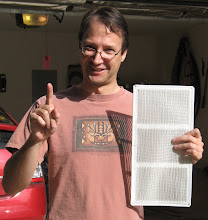After experiencing the dramatic cooling capability of even a partial radiant barrier installation, I raised the priority of finishing the barrier over the coming winter. As the weather started to cool, and the fierce Texas sun began to travel south for the winter, leading the Canadian geese and Mexican free-tail bats to warmer climes, I began to spend longer sessions in the attic in an attempt to finish the work.
As I continued to work in the attic installing radiant barrier, one thing that I noticed was that looking around the attic, I could see a lot of wood sticking up out of the insulation, wood that made up the joists for the ceilings below me. This can be a bad sign; typically, as I understand it, one should have enough insulation depth that the wood is pretty well entirely covered. This reduces heat flow from the attic air into the wood, which is important because the wood is in very direct thermal contact with your ceiling. Plus, unless your ceilings joists are _really_ thick, the fact that the wood is showing through means that your insulation is not really very thick.
Now, perhaps some of you are thinking, "what does this have to do with installing radiant barrier?" And you would be right to ask that question. In fact, I had distracted myself once again from the primary mission through another bout of mission creep, this time, to improve the insulation while I was in each particular area of the attic.
Next: read on, to determine what this little diversion into the fascinating science of insulation has to teach us, and learn what efficiencies are in store!
Wednesday, October 21, 2009
Subscribe to:
Post Comments (Atom)


No comments:
Post a Comment